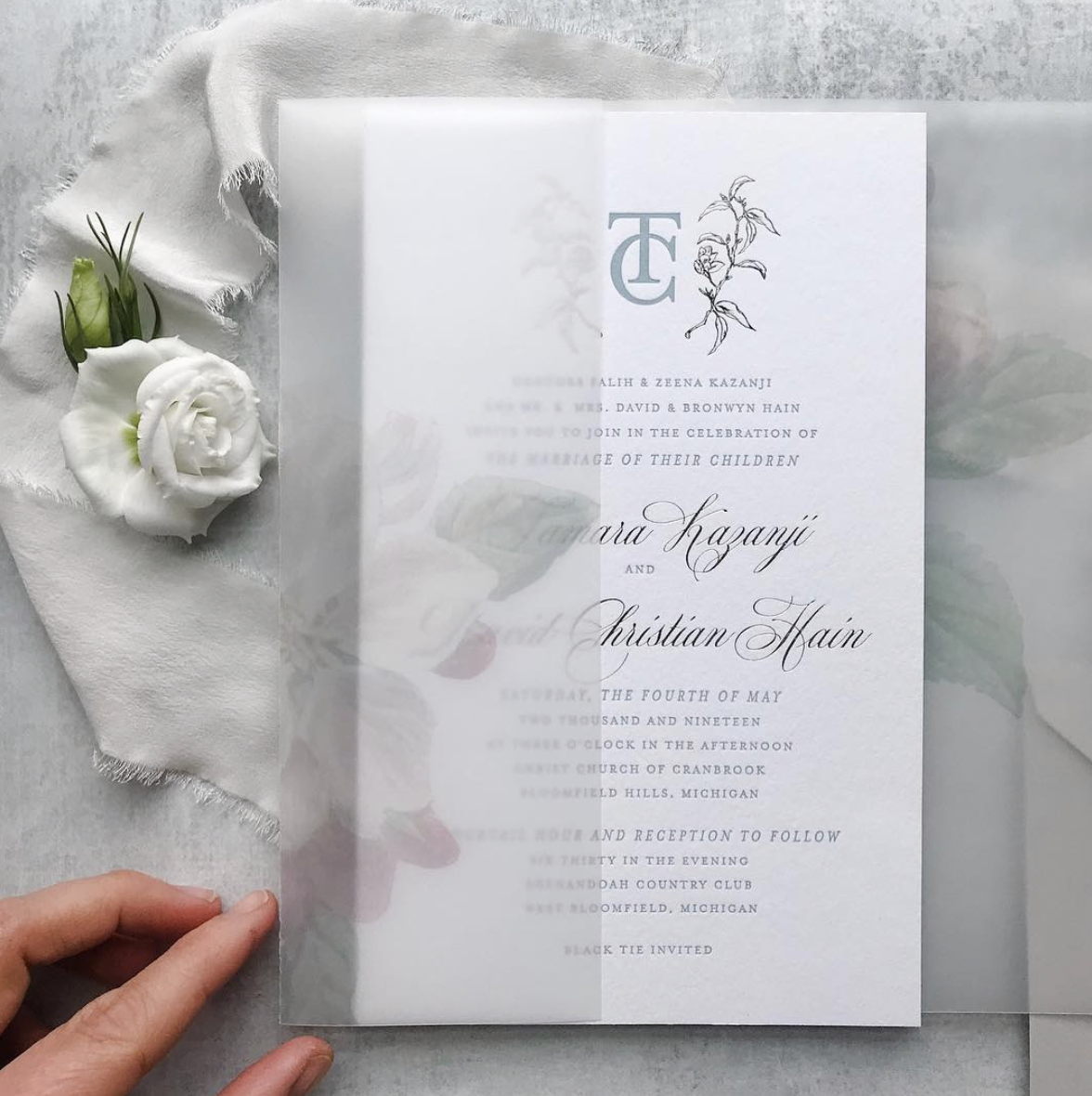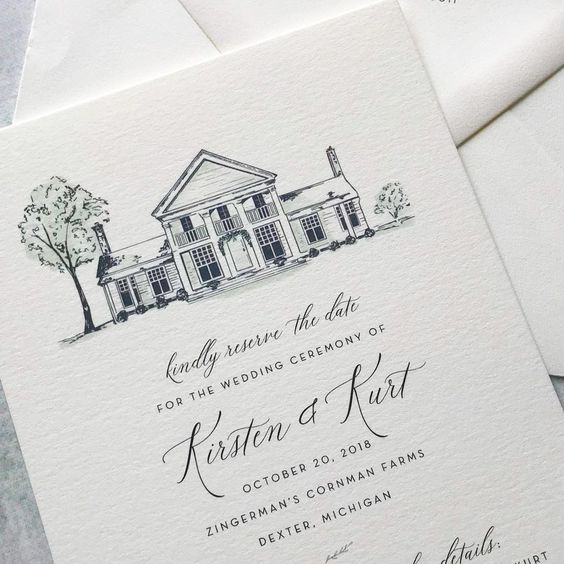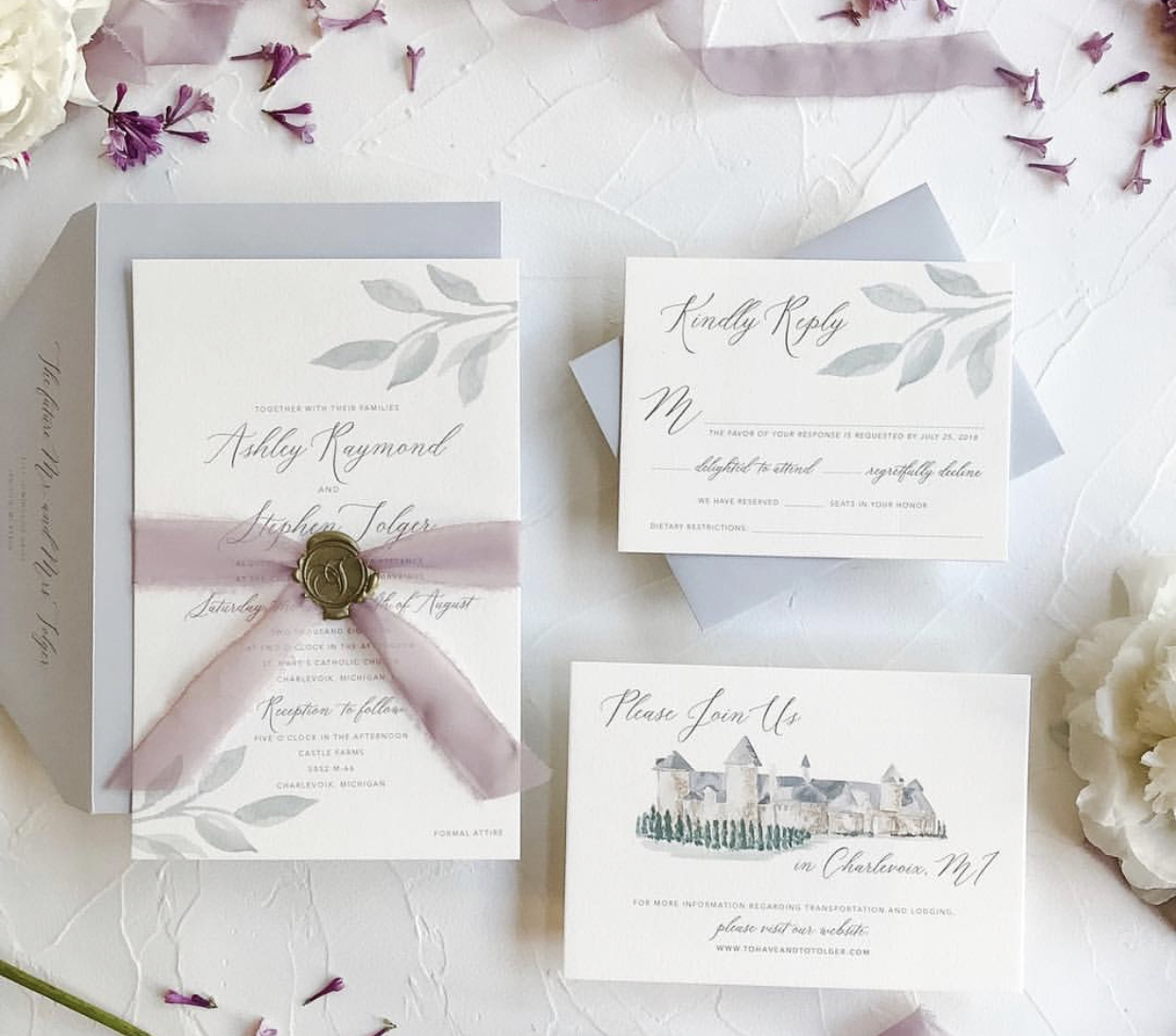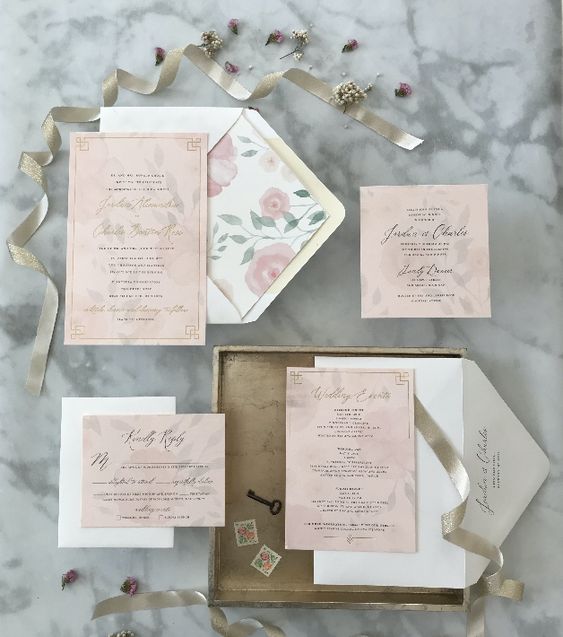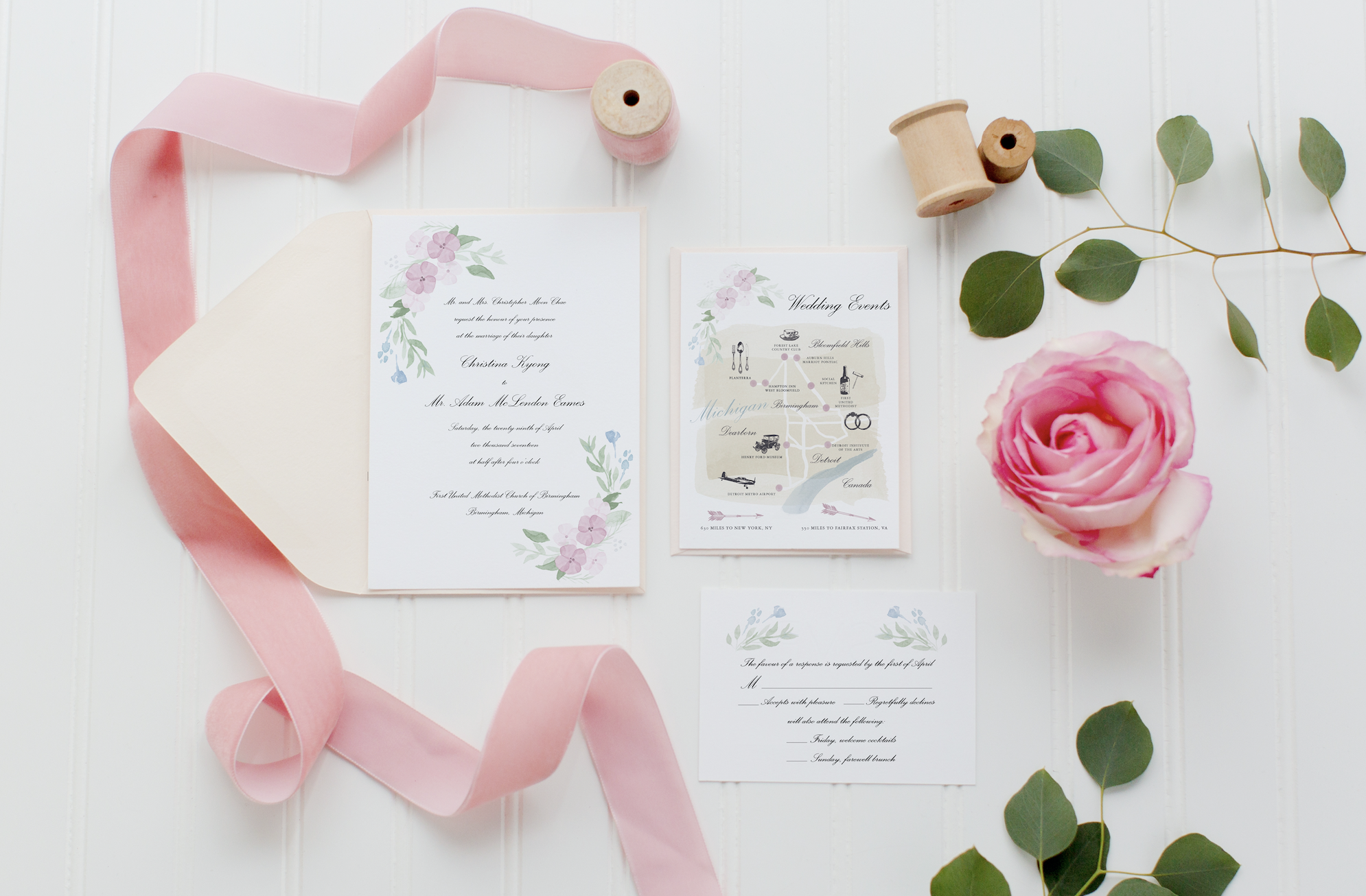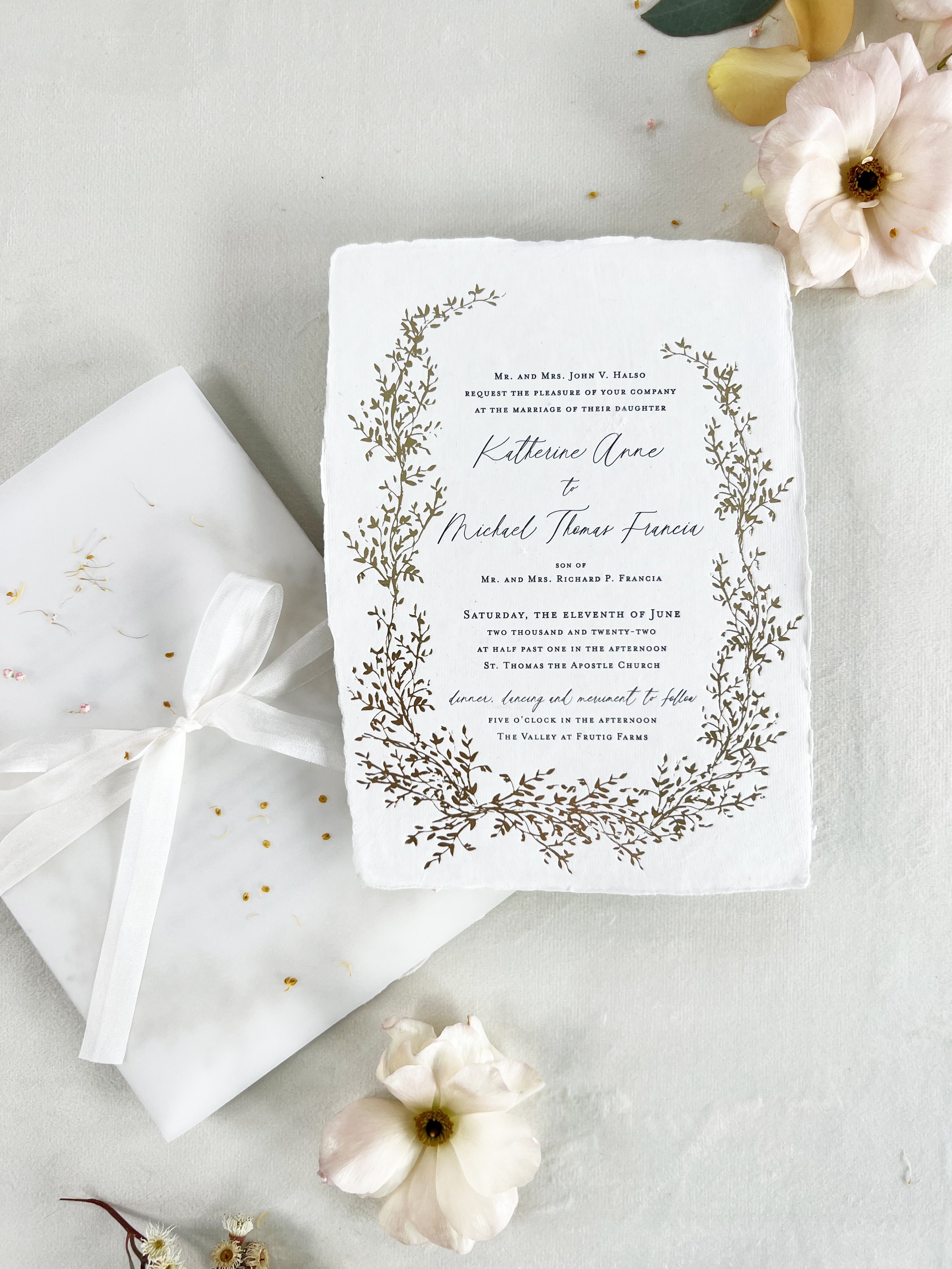Wedding ETIQUETTE GUIDE
Congratulations on finalizing the specifics of your wedding! You’ve set a date, booked your wedding venue, and now you can make it official with your wedding invitations. The most important wedding etiquette is making sure your guests get all the information they need. A basic invite has 10-12 lines, each playing its own role in the invitation.
Wording Etiquette
gifts
It’s considered impolite to mention gifts anywhere on your invite. Even if you are saying “No gifts please” it is considered rude because it implies that gifts are expected.If you have a registry, you can list all gift and registry information on your details card or wedding website.
children
Even if you don’t want children at your wedding, let the guests know this information through the outer or inner envelopes by including (or not including) children’s names. On more casual invitations it’s acceptable to write “adults only”, but never use strictly exclusionary language (like “No children under age 10”, etc.).
websites
The standard is to include your URL on your Save the Date. If you’re not sending Save the Date cards, you can include a separate enclosure with your invitation set that lists the URL, or you can include the URL on the back of the invitation. It is generally not needed to include “http://” at the beginning of the URL, and it saves space on the card.
dress code
The general rule for dress code basically says not to include a dress code on your main invite. Your guests should be able to assume the level of formally based on the venue and time of day of your event.
However, if your dress code is a bit out of the ordinary, go ahead and indicate the dress code on the bottom right corner of your invitation. Another option is to include a separate attire card in your suite or save some paper by putting the information on your website.
Spelled out
Almost every word on your wedding invitation will be spelled out. You may use titles like Mr. and Mrs. but you must spell out the wedding date, time and year as well as words and numbers in the venue’s address, like court and avenue.
punctuation
Line breaks act as commas and periods in wedding invitation wording. You may use periods in titles like Mr. and Mrs. and commas if separating information in the middle of a line.
Capitalization
Do no capitalize the first word of each line. Only capitalize the first word of the invitation and all proper nouns. Capitalize any line that stands on its own if it would be the start of a new sentence.
last Names
A last name isn’t needed for the bride or groom if their parent’s names are included on the invitation. It’s considered redundant.
divorced parents
The names of the married couples are on the same line. The names of divorced couples are on separate lines.
Below is a detailed outline and description that will give you a better understanding of the purpose for each line of your wedding invitation, as well as some important things to remember for your other wedding stationery items.
HOST LINE
The host line indicates the host of the event and who is issuing the invitation. Traditionally, this role was filled by the bride’s parents, but today most couples host the wedding themselves or with their families. No matter who is issuing the invitation, there’s a host line format fit for their invite.
REQUEST LINE
The request line plays the most important role in the invitation: it actually invites the guest to the event! It’s important to keep in mind that the wording of the request line changes depending on whether the venue of your event is religious or not. Invitations to events held at a religious venue use the phrase “request the honor of your presence”; secular events use the phrase “request the pleasure of your company”. While this is a tradition that is still widely used today, more and more couples are choosing to forego the conventional phrasing and make use of more fun and celebratory request lines.
EVENT LINE
Working with the request line, the event line lets the guest know to what event they are being invited to. This line specifies the type of event (marriage, reception, or anything else) and traditionally, the relationship of the host to the bride or groom, but it’s no longer necessary to include this relation.
BRIDE LINE
Following the event line is the bride line. Wedding invitation etiquette states the bride’s name comes first. Depending on the formality of invite, you might or might not need to include the bride’s title, middle name, or last name. (This is a well-established practice, but the wedding is about the bride and groom— we think you should write the bride’s name however she feels comfortable!)
JOINING WORD
Between the bride and groom lines is the joining word. This line serves to connect the names of the spouses-to-be and while it plays a simple role, the joining word does change depending on a few factors, namely the type of the event and its religious association. The word “to” between the bride and groom’s names indicates a Christian wedding, while the word “and” indicates a Jewish wedding. “And” is also used on invitations issued by the bride and groom, and wedding reception invitations.
GROOM LINE
Similar to the bride line, the groom line simply states the name of the groom. Writing the groom’s full name and his title is considered standard. (Again, this is a well-established practice, but the wedding is about the bride and groom— we think you should write the groom’s name however he feels comfortable!
DATE LINE
The date line follows the groom line and states the day of week, date, and month in which the event will take place. Depending on the formality of the invitation, you might or might not need to write out numbers in words.
YEAR LINE
The year line simply states the year of your event. This line, however, is one of the only optional lines on the invite. It’s optional because it is generally assumed that the event will take place six to eight weeks after the invite is received. There isn’t any situation in which you absolutely must or mustn’t include the year line, so do whatever feels right for your invitation. If you do choose to include the year the word “and” does not belong in the year. The word “and” in numbers actually represents a decimal point. Instead of two thousand and twenty you would write two thousand twenty.
TIME LINE
When stating the time of your event, the timeline changes depending on the level of formality of your invitation. If your invite is in a traditional or formal style, be sure to write out all numbers in words. If your event will be taking place at a half or quarter hour, indicate this by writing “half after”, “a quarter after”, or “three quarters after”. It is not necessary to indicate time of day unless your start time is ambiguous, like nine or ten o’clock. If you do choose to include time of day, indicate it using phrases like “in the afternoon” or “in the evening” rather than just tacking on an AM or PM. (If your invitation is more casual, however, feel free to ignore all of these rules!).
LOCATION LINE
The location line states the full name of the venue where your event will take place.
ADDRESS LINE
The address line, which states the address of the venue, is the next optional line. There are actually only a few scenarios in which you would include this line, such as when there is another facility with the same name as your venue or if the facility is not well known. If your invitation has a traditional or formal tone, do not use any abbreviations or casual language; write out all street or building names completely.
CITY AND STATE LINE
The invitation wraps up with the city and state line, which lists the city and state of the venue. If your invitation is taking on a traditional or formal tone, be sure not to abbreviate any of the names.
ETIQUETTE OVERVIEW
These are just the basics, but hopefully you now have a solid foundation to create the wording for your invitation. Each line takes on its own role and has its own etiquette, but the purpose of each line is the same: to relay information about your wedding as concisely and politely as possible. That being said, if an etiquette rule will lead to hard feelings, it’s completely fine to ignore it. The point of etiquette is to treat guests with respect. If it fails to do so, there’s no harm in modifying your invitation so that every guest feels welcome.
And don’t be scared to mix it up— while the order of lines presented in this document is considered standard, times have changed. If you’d rather combine the date and year line or ignore the host line, feel free! While etiquette is important, there’s one part of the invitation that should never be forgotten: the preferences of you and your spouse-to-be.

